Biography Of Nikola Tesla, The Forgotten Genius Of The World Of Electricity
The Great Serbian Scientist Nikola Tesla Is One Of The Most Influential Figures Of The Twentieth Century, Whose Important Role In The History Of Electricity Is Unknown To Many.
Nikola Tesla is a Serbian-American scientist born on July 10, 1856, in the village of Smilja in the Austrian Empire (present-day Croatia). Tesla has won many scientific titles, including inventor, electrical engineer, mechanical engineer, physicist, and futurist.
The most famous achievement of this great scientist is the modern AC power supply system.
Nikola Tesla was born in the Austrian Empire and had a degree in physics and engineering.
In the 1880s, he gained useful experience in electrical science by working for communication technology companies and Continental Edison.
After immigrating to the United States in 1884 and briefly working for Edison Machine Works, he left the company to pursue his creative ideas.
With the help of his business partners, he established several laboratories and companies to develop his plans in mechanical and electrical engineering in New York.
Alternating current induction motor patents and patents related to multiphase technologies were among his achievements. During that time, Tesla was able to make a decent profit by selling them to Westinghouse Electric.
Nikola pursued his various designs with the income earned and gained extensive experience in electrical discharge tubes, X-ray imaging, and mechanical generators.
He displayed his achievements in his laboratories to famous and influential people.
Many people know him with special shows of his inventions.
In the 1890s, Tesla tested his ideas for wireless transmission of electricity and conducted experiments with high frequency and voltage. In 1893 he announced that he could establish a wireless connection between his devices.
All these ideas were pursued in his famous and unfinished tower called Wardenclyffe Tower.
Eventually, Tesla was unable to carry out these projects due to a lack of funding.
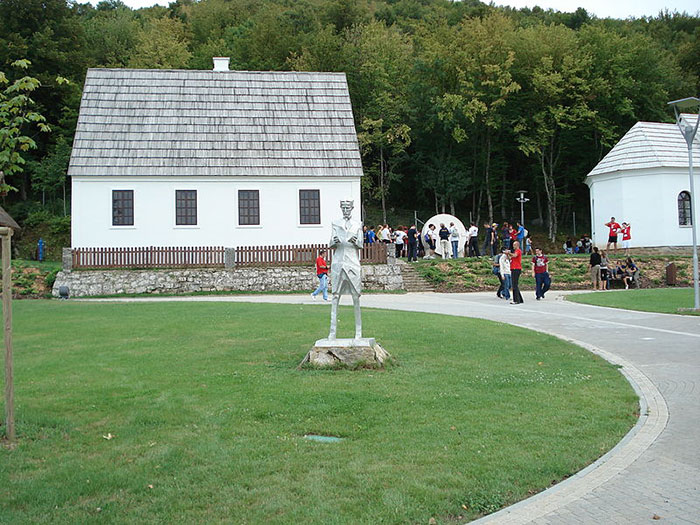
In later years, Tesla experimented with other ideas, each with relative success. Lack of funds, high debts, and unsuccessful projects led to the popular culture calling him a mad scientist.
Nikola Tesla died in January 1943, and many of his achievements were forgotten. In 1960, the International Conference on Weights and Measures named the International Magnetic Field Unit Tesla in honor of this great scientist.
Birth and early years of education
Nikola Tesla was born in the village of Smiljan. The village was under the control of the Croatian military in front of the Austrian Empire in those years and is now part of Croatia.
His father, Milutin Tesla, was an Orthodox priest. His mother, Duka Tesla, was also the son of a priest.
Nikola Tesla’s mother was highly gifted in manufacturing tools and equipment and applied mechanics applications. He was highly gifted in memorizing Serbian poetry but never had an academic education. Nicola inherited her innate talent for creativity and strong memory genetically and educationally from her mother.
Nicola was the fourth of five children.
He had three sisters, Mika, Angelina, and Marika, and his older brother, Dean. He went to Similan Elementary School in 1861, where he studied German, mathematics, and theology. The family moved to Gospic in 1862 to have his father serve as a local priest there.
Nicola completed her primary and secondary education in the city. He moved to Karlovac in 1870 to attend high school at the Higher Real Gymnasium.
Tesla, an intelligent student, became interested in science through his physics teacher during his high school years. He stated somewhere that he was eager to discover the source of this mysterious force.
His genius and memory were very high, and he was able to calculate the integral action mentally. This genius was so great that some teachers condemned him for cheating.
He was able to complete a 4-year high school course in 3 years.
Nicola returned to his hometown in 1873 and soon contracted cholera. His illness lasted for 9 months. Nicola’s father had promised to send him to the best engineering university if he recovered from his illness.
In 1874, after recovering from illness, he was drafted into the Austro-Hungarian army in Smilyan; But Nicola escaped the call and went to the village of Tominaga in Gracock.
He mentions these years as influential years in his morale, which he was able to regain his morale after illness by reading Mark Twain’s books and being in natural areas and close to nature.

In 1875 he went to the Graz Polytechnic to continue his education.
In the first year, he showed great genius and effort and was accepted with excellent grades in all courses. The university also sent a letter to his father announcing his high status and talent, in which Nikola was mentioned as the star of the college.
In his sophomore year, Nicola had many discussions and disagreements with his professor, Professor Poeschl.
They were working on a gram machine, and Nikola believed that it did not need a switch.
Tesla worked very hard as a student. He claims to have been working and researching every day of the week without a break from 3 am to 11 pm. After his father died in 1879, he collected university letters to his father warning the Tesla family.
The letters stated that if Nicola were not expelled from the university, he would definitely die because of too much work. In the later years of his studies, Nicola became addicted to gambling and lost much of his income and savings.
Although he broke the habit several times, he eventually failed the third-year university exams and never graduated.
Nikola Tesla left Graz in 1878 and cut ties with the rest of the family.
He did not want them to notice that he was leaving the university. Many of Nicola’s relatives in those years thought he was dead. He moved to Maribor, present-day Slovenia, where he worked as a designer.
Gambling addiction did not leave him during these years. He experienced an acute psychological breakdown in 1879 after his father refused to return home.
Tesla’s last attempt at university education took place in 1880.
Her uncles gave Nicola money to continue her studies at Charles Ferdinand University; However, he did not speak Greek and missed the time to apply to study, so he could not enroll in the university courses and, as mentioned, he never received a university degree.
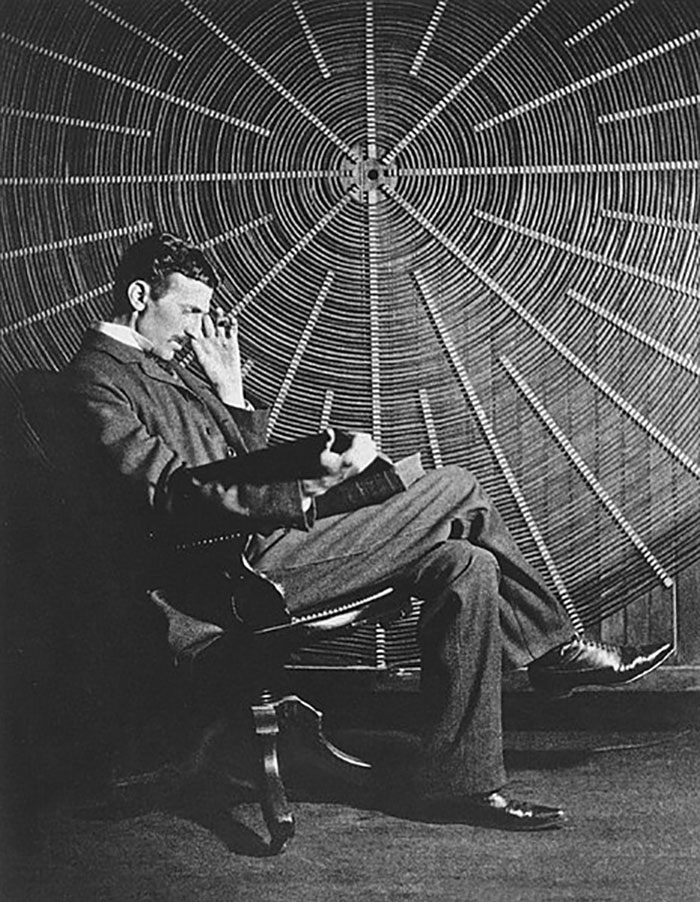
Immigration to Hungary
Nikola Tesla moved to Budapest, the capital of Hungary, in 1881 to work for the Budapest telephone exchange under Tiwada Pusk.
At the beginning of his career, the company was not very active, and Nikola started working as a draftsman and designer at the headquarters of the city telegraph. After the official launch of the company, Tesla became the director of its electricity department.
During Tesla’s tenure at the company, he made many designs and improvements to the central station telephone and electricity system.
He claimed to have invented a telephone amplifier during this period, which was never introduced or patented.
Hired at Edison Company
In 1882, he sent Tesla Pushkash to work at the Paris branch of Edison International. Edison’s main field of work was the design, installation, and implementation of indoor lighting systems with incandescent lamps.
Tesla worked at the company’s Ivry Sur Seine branch. He had a great talent for learning new sciences and gained a lot of experience working in this company.
Realizing his high talent, Edison executives gave him more responsibilities, including alternator design and advanced engines. Equipment from other Edison branches that needed repair was also sent to Tesla.

immigration to the U.S
In 1884, Charles Bachelor, Edison’s Paris branch manager, was called to New York to run the Edison Machine Works plant. He also invited Tesla to emigrate.
Tesla accepted his invitation and worked in the large Edison plant in the first days of his arrival in New York. A factory with numerous workers and engineers and advanced machinery to manufacture large-scale electrical equipment on an urban scale.
In this factory, like the Paris branch, Tesla was responsible for solving the problems of installing and operating generators.
During his years at the Edison plant, Tesla had several brief meetings with its founder, Thomas Alva Edison.
One of these meetings was when Nicola was working late at night repairing a generator at the factory, and Edison and Bechler, who were talking to each other, saw him. Tesla said in an interview that when Edison found out, he was working late on the project, he told Bachelor that he was a great person to run.
One of Tesla’s projects at Edison was to improve the company’s arc lamps for installation in urban environments. These bulbs, which required very high voltage, could not be operated with Edison factory systems, which was a failure for the company.
Tesla improved these lamps, but his plans never materialized.
This could improve the city voltage system or Edison’s contract with other factories to produce lamps.
Tesla left the big Edison plant after six months. The reasons for leaving the company are not yet clear. Most likely, the reasons for this decision are the misconduct of Edison and Tesla’s direct manager in rewarding him.
In several interviews and notes, Tesla talked about the promise of rewards for inventing and building new equipment, but it never materialized.
He went on to say that Edison’s executives, after doing the work, considered the proposals a joke and told him that he had not yet understood the American humor culture.
However, Tesla resigned from Edison on January 4, 1885.
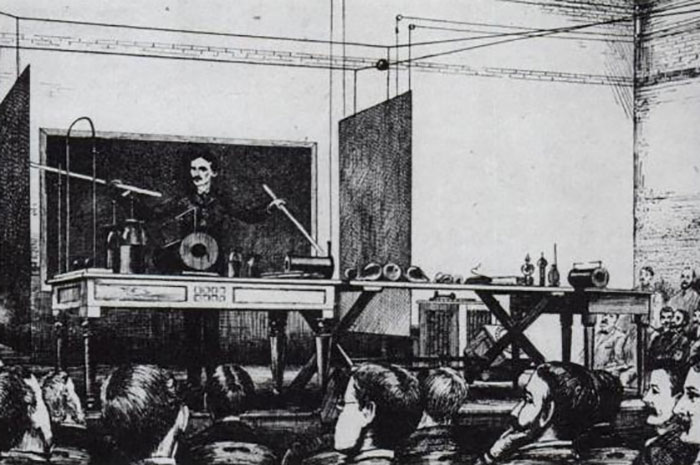
Tesla Electric Lighting Equipment Factory
As soon as he left Edison, Tesla worked on a patent for arc lighting systems. He sought help from Edison’s patent attorney, Lamol Searle.
Searle introduced him to two well-known businessmen, Robert Lane and Benjamin Will, and eventually, with the help of these two investors, started the Tesla Electric Light & Manufacturing plant.
In its first year, Tesla developed and developed its advanced DC generator, launching it for the first time in New Jersey at the factory.
Tesla’s advanced generator technology made the tech media of that day praise him.
Sometime after the factory opened, investors in 1886 concluded that the manufacturing sector was not profitable enough, so they decided to leave the factory.
They started another company and left Tesla alone. Nikola Tesla, who also lost his patent license due to a donation to the factory, faced many difficulties this year and was forced to accept part-time jobs, even as a repairman. He described this year as one of the most difficult years of his life and said somewhere:
I felt that all my professional studies in various scientific fields, including electricity, mechanics, and even literature, were ridiculous and useless.
Tesla Electric Company
In 1886, Nikola Tesla met with Alfred Brown, head of Western Union, and Charles Pack, a New York City lawyer. These two people had a long history of starting different companies and introducing ideas to investors. Those who saw Tesla’s new ideas on various subjects, including magnetic heat engines at the time, offered to attract an investor and pursue patents.
Finally, the Tesla Electric Company was founded in April 1887. In the company’s contract, the profit of registering Tesla patents was divided into three parts. One part was used for Tesla, one for Pack and Brown, and one part for capital increase.
The first set up a lab in Manhattan, New York, where Tesla could test generators, motors, and other electrical equipment.
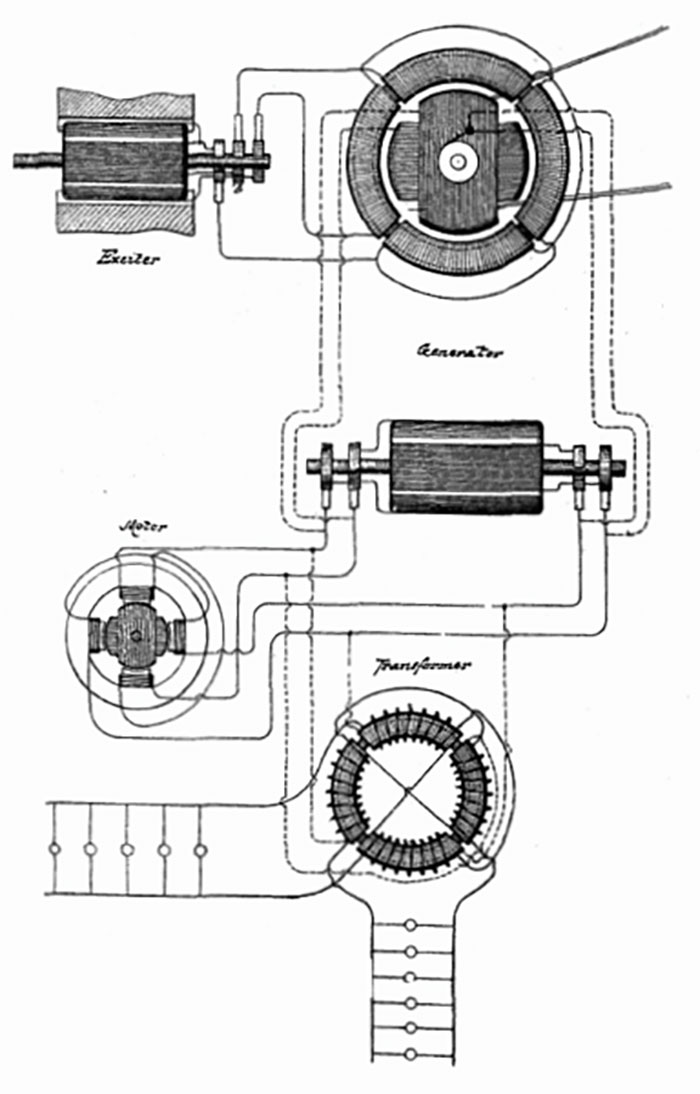
The invention of induction motor
In 1887, Tesla invented an induction motor that used AC power. This type of electricity was developing in those years, and high voltage over long distances was one of its special advantages.
Tesla’s motor used a multiphase current for rotation. This current created a rotating magnetic field for the motor to rotate. The motor did not need a commutator or current-carrying current to operate, so it operated easily.
After the induction motor patent was filed, Tesla consultants offered him to make it public. On May 16, 1888, they exhibited the motor at the American Society of Electrical Engineers. Engineers at Westinghouse saw the Tesla product and reported it to George Westinghouse.
Westinghouse had long been looking for an AC motor, and Tesla’s invention could be a great help to them.
Eventually, the offer to buy the patent was communicated to Tesla and his attorneys, who sold the right to use the patent to Westinghouse at a high price.
Under the agreement, Tesla and his associates were paid $ 60,000 in cash and shares and $ 2.5 per horsepower generated by each engine.
In addition, Westinghouse hired Nicola for a year with a salary of more than $ 2,000 a month (currently $ 53,000) to work as a consultant for the electrical and manufacturing department at Pittsburgh Laboratories.
Shortly after the Tesla-Westinghouse agreement, competition between the Edison, Westinghouse, and Thompson-Houston power companies intensified, followed by the recession of the 1890s.
During this time, Westinghouse was unable to meet its obligations to Tesla, and its director apologized to him, declaring that Tesla should withdraw its claims from the banks.
Eventually, Tesla canceled its contract with the company. Six years later, Westinghouse paid Tesla $ 216,000 to buy the patent right after signing a patent-sharing agreement with General Electric (created by the Edison-Thompson-Houston merger).
Other inventions and achievements
After selling his patent, Tesla made a lot of money and pursued his own experiments and ideas. He left the clinic rented to him by Pack and Brown in 1889, and in the following years, working with his own staff in his own laboratories and workshops.
He experienced many ambitious experiments during these years.
Tesla Coil
In 1889, Nicola became acquainted with Heinrich Hertz’s research in electromagnetic waves, and he became very interested in studying and advancing in this field.
In one of his experiments, he attempted to power an induction coil with a high-speed generator, which melted the insulating material in the coil at high frequency.
That’s why Tesla came up with a new design, using air instead of insulation, and finally inventing its own induction coil system called Tesla. He patented his invention in 1891 and obtained US citizenship in the same year.
Wireless lighting
From the beginning of 1890, this great scientist focused on the development of wireless lighting systems. He tried to transmit electricity wirelessly with the help of inductive and resistive couplings and alternating high voltage current.
Tesla made numerous presentations to the public, and in several successful attempts, was able to turn on incandescent light bulbs without connecting wires.
In later years and throughout this decade, Nicola’s main focus was on this system. Numerous investors worked with him during this period, but none could produce commercial products from his invention.
From 1892 to 1894, Tesla served as vice president of the American Society of Electrical Engineers (now known as the IEEE).
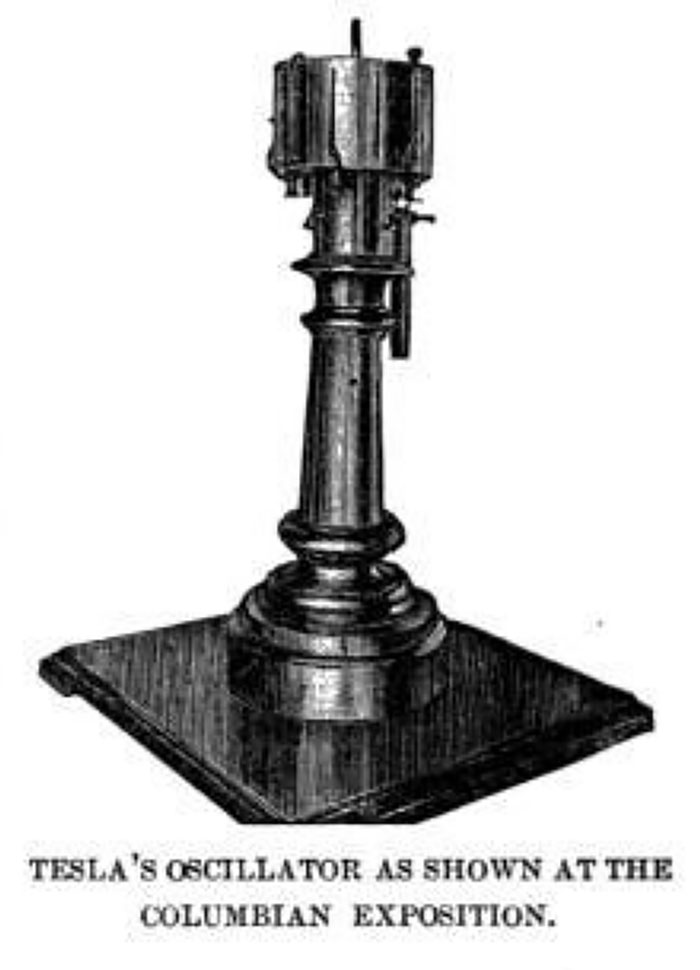
Tesla oscillator
Tesla made great efforts to invent a device to produce alternating current better. Finally, in 1893, he invented an oscillating system powered by steam energy.
Tesla’s oscillator worked so that steam entered from one side and exited through its holes. This movement of steam moves the piston attached to an armature.
The up and down motion of the armature and its high-velocity vibration produced an alternating magnetic field. Eventually, this field leads to the generation of alternating current in the parallel windings of the device.
This device had many complexities in the steam sector and never led to an engineering solution for power generation.
Niagara Falls Power Generation Consulting
In 1893, Edward Dean Adams, director of equipment production and operation at Niagara Falls, asked Tesla for advice on choosing the best power system and equipment.
Different companies were building generators and power generation equipment produced in 2-phase, 3-phase, and direct current with high voltage. Tesla suggested to Adams that it use a two-phase AC system.
Following Tesla’s advice, he signed a contract with Westinghouse Electric to build the AC power system. He also contracted with GE to design and build the AC power distribution system.
After this project, Adams, absorbed in Tesla’s ideas and genius, helped him establish his own independent company, Nikola Tesla Company.
In 1895, the building where Tesla’s laboratory was located was set on fire, and many of his ongoing projects, designs, and prototypes were destroyed.
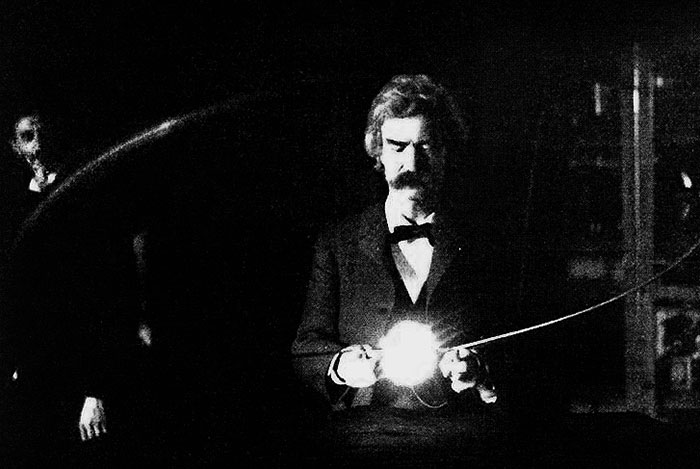
X-ray tests
In 1894, Tesla conducted several experiments in X-ray imaging. He randomly recorded images during his experiments that could be identified as X-ray images. But Wilhelm Conrad Roentgen is the man known as the inventor of X-rays.
However, after Rntgen announced the discovery of this radiation in 1895, Tesla the following year tried to produce its own prototypes of the technology. As he progressed in this field, he realized the dangers of these rays to the body.
However, it was later revealed that the bodily injuries were due to ozone in the experiments.
Remote control boat
In 1898, Nikola Tesla introduced the radio-controlled boat. The boat was controlled using Coherer radio control, and Tesla chose the title Teleautomation. People who witnessed the launch of Tesla’s product looked at it with great surprise and considered it magical. Tesla tried to sell his plan to the US military but failed.
Wireless electricity
One of Tesla’s biggest and most ambitious projects has been wireless transmission. After initial successes in wireless lighting, Tesla focused on the project from the 1890s to the 1906s. He believed that electricity could be transmitted wirelessly over long distances and that wireless communications could be extended over long distances.
He conducted several experiments in this field and finally concluded that the Earth’s atmosphere is conductive.
Tesla then released a plan consisting of multiple balloons to generate, receive, and transmit electricity.
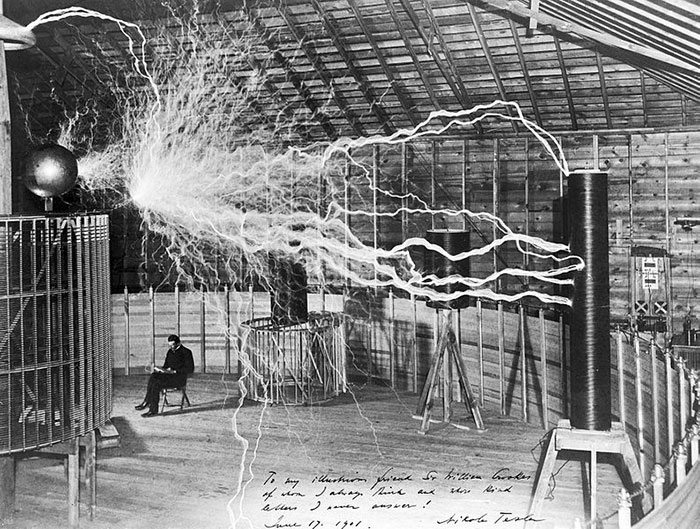
In the following years, Tesla attracted investors and set up a laboratory in Colorado Springs to test its idea at high altitudes, but never succeeded. Nikola claimed to have received vague signals in his lab during experiments with wireless power transmission that he interpreted as messages from extraterrestrial beings.
In the June 1900 issue of Century Magazine, an article was published on Tesla’s findings and inventions entitled The Problem of Increasing Human Energy, which sought to explain his wireless system.
Of course, this article had become more of a long philosophical treatise than a scientific and comprehensible article.
Finally, this article can be called a symbol to show the greatness of Tesla and the Colorado Laboratory.
Continuing his research into the project, Tesla persuaded Jay Pierpont Morgan in 1901 to help him advance $ 150,000 in wireless research.
Eventually, a contract was signed, and Tesla began building the Wardenclyffe Tower to pursue his ambitious project.
At the same time, Marconi, who had previously made general findings of radio communications, was able to send the world’s first radio message, defeating Tesla.
As a result of this defeat, Tesla again tried to raise capital but failed.
Many investors and critics dismissed Tesla’s experiments as futile and sought to invest in Marconi designs in the years that followed.
The Wardenclyffe also became Tesla’s biggest failure in life, forcing him to sell it to pay off his debts.
In the following years, Tesla made great efforts to attract investors or sell its patents, but in 1925 it became bankrupt.

Bladeless turbine
At the age of 50, in 1906, Tesla introduced a 200-horsepower bladeless turbine with a rotational speed of 16,000 rpm. He tried hard to commercialize the turbine but was unsuccessful.
He eventually sold the idea to a precision instrument company. Finally, this design was used in the accelerometer of luxury cars.

Personal life
Nikola Tesla was a regular, hardworking, and, of course, lonely person. He devoted many hours to work, and his time to eat, exercise, and work was exact. He valued his appearance and was one of the most dignified scientists of his time.
Nikola Tesla’s memory was powerful. He read a lot of books and memorized them completely. He also had a precise visual memory and could only memorize the details of an object when he heard it.
Tesla was fluent in eight living languages of the world, including Serbian, Czech, English, French, German, Hungarian, Italian, and Latin.
Nikola Tesla never married. He once stated that he thought his character was worthless to a woman. She has often been recognized as an advocate for women’s rights and, of course, has been critical of women’s attempts to engage in masculine behavior.
According to him, women have been becoming men to increase their power.
In the last years of his life, Tesla stated that not getting married was one of his greatest sacrifices for his work.
Nikola Tesla died on January 7, 1943, at the age of 86. He spent the last day of his life in room 3327 of the New Yorker Hotel, and his body was found two days later by a hotel attendant.
His niece worked hard to get Tesla’s assets back to her hometown, and that happened in 1952 when 80 large funds returned all that was left of Tesla’s assets to Belgrade.
In 1957, the ashes of Nikola Tesla were transported from the United States to Belgrade, and since then, they have been kept in a golden sphere in the Nikola Tesla Museum.
Since the death of Nikola Tesla, numerous companies, groups, venues, and awards have been registered in the name of this great scientist.













